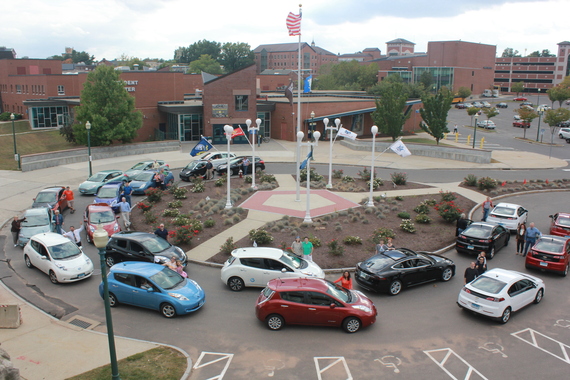Co-authored by Mike Walker, Founder and CEO of AlterAction
Compared with conventional cars, plug-in electric vehicles (EVs) dramatically reduce greenhouse gas emissions. This is true even after accounting for the power plant emissions from the electricity to charge them. That's why environmental groups have been calling on policy makers, auto makers, the media, and the public to support an accelerated switch to plug-in cars while simultaneously slashing fossil fuel emissions in other ways -- like improving mass transit and expanding solar power.
In his State of the Union address four years ago, President Obama said, "[W]e can break our dependence on oil ... and become the first country to have 1 million electric vehicles on the road by 2015." Today we can more accurately estimate that we'll have roughly 400,000 EVs on the road by the end of 2015. We will likely hit the 1-million mark around 2018. Still, not a bad start for a new category of passenger vehicles. EV sales have grown faster out of the gates than hybrid cars first did.
But we can -- and should -- do much better. Indeed, late last year EVs made up only about 0.85 percent of total U.S. auto sales.
Sierra Club, the major environmental group, hired AlterAction, a behavior change consultancy, to produce an in-depth analysis of the U.S. EV marketplace. One finding really struck us: The U.S. needs 10 million EVs on the road by 2025 to have a shot at avoiding the worst effects of climate change.
Credit: Gian Metzger of New Britain, Connecticut
Even AlterAction's sunniest market projection indicates that we'll have only 4 to 5 million EVs on the road by 2025 if we charge ahead at the current modest pace of growth. But we believe an aggressive campaign promoting the most effective EV programs and policies in the right locations could bump that number to 6 to 8 million EVs by 2025. And with many more NGO, government, and corporate stakeholders making this a priority issue, we could actually reach that 10-million-EVs mark within the next decade.
How do we get there? As we wrote in our last post in this blog series, some EV programs clearly are already working and should be expanded and replicated. These include high-level EV taskforces put in place by state government leaders, consumer incentives that make EVs cheaper to buy and more convenient to operate (such as cash rebates and carpool lanes access), initiatives that encourage the installation of charging equipment at places of work, and utility programs (such as off-peak charging rates and outreach to their customers).
And where in the country do we focus our attention? Part of the answer is the eight Northeast and West Coast states whose governors have already committed to the Zero Emission Vehicle Action Plan. That plan promises 3.3 million EVs will hit the roads by 2025. There is a lot of work to be done in these states to meet these commitments. Recently, a coalition of businesses and NGOs provided some specific recommendations and urged the governors of all the Northeast and Mid-Atlantic states to ramp up their EV programs.
We shouldn't ignore certain other pockets of the country where we can accelerate EV adoption, too. For example, Georgia is among the most popular states for EVs because of its generous $5,000 EV consumer credit, which advocates are currently fighting to defend. A recent report shows that EV drivers in Georgia are currently saving a combined $10 million a year in fueling costs, and last year these Peach State drivers prevented 22,000 tons of GHG emissions. Additionally, Kansas City Power & Light recently announced it plans to install 1,000 EV charging stations, which could boost EV sales in part of the Midwest.
In California, Pacific Gas & Electric just announced its plans to install 25,000 new EV charging stations, including at two of the most important types of locations for EV chargers: at workplaces and multi-unit dwellings. The air quality is so bad in parts of south and central California that policy makers have set a goal to electrify nearly all passenger vehicles on the road by 2032. Translation: Even the Golden State, the EV capital of the U.S., needs to significantly ramp up its ambitious EV programs.
Getting to 10 million EVs in the U.S. by 2025 will be a major challenge, but we know a lot already about what works and where to focus. In our next post, we'll lay out a vision for how to get the public charged up and demanding these cars.
Mike Walker is the founder and CEO of AlterAction, and his blog is here. Gina Coplon-Newfield is the Sierra Club's Director of Electric Vehicles Initiative. Emily Norton and Jeff Fisher also contributed to this post.

